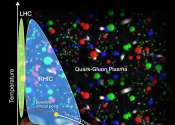Calculation shows why heavy quarks get caught up in the flow
Using some of the world's most powerful supercomputers, a group of theorists has produced a major advance in the field of nuclear physics—a calculation of the "heavy quark diffusion coefficient." This number describes how ...









